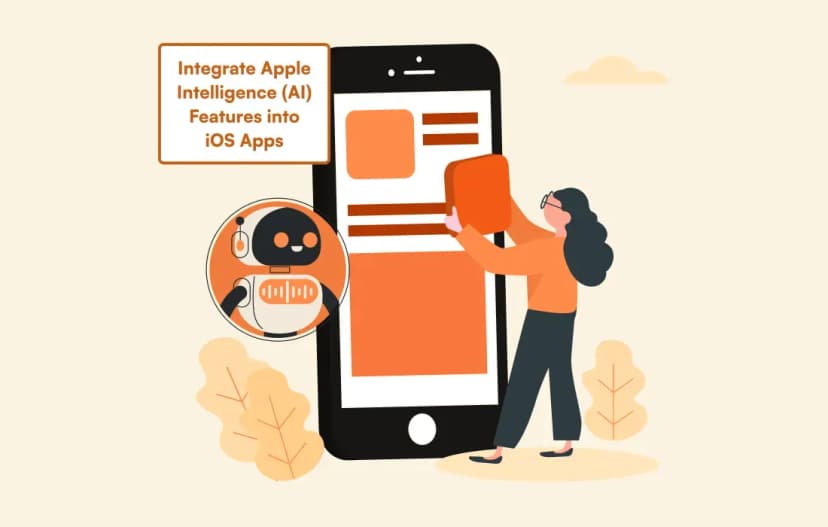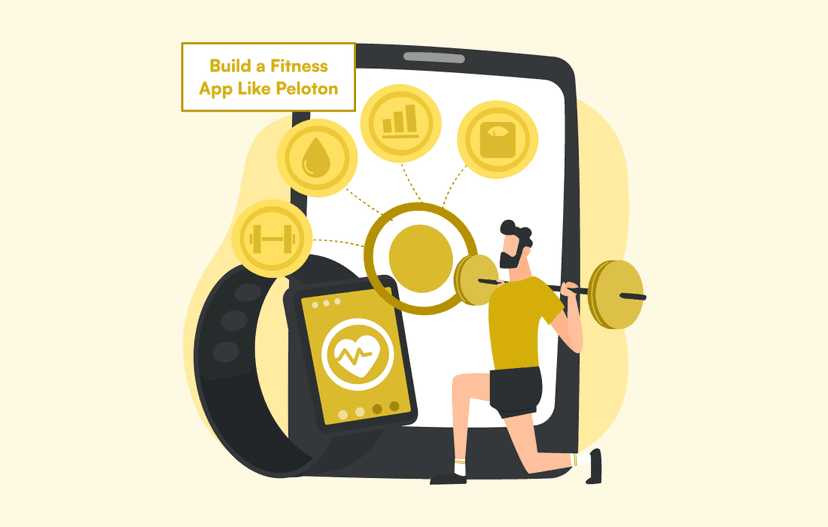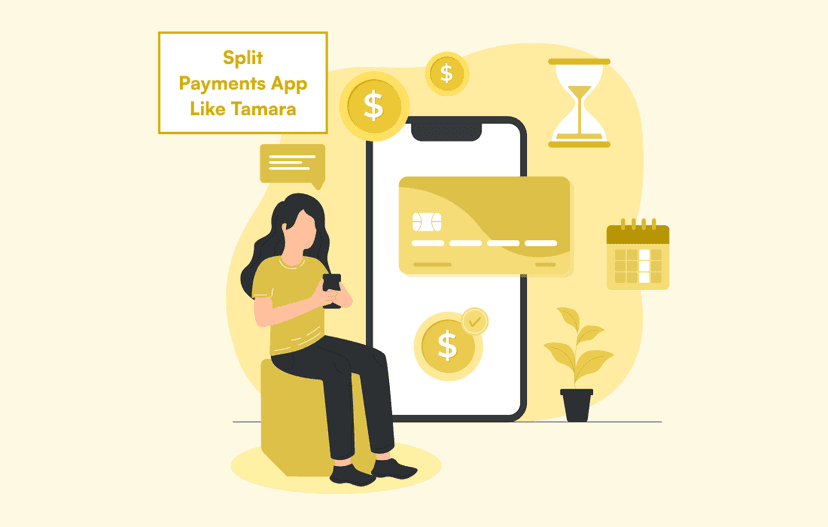How to Develop a Meditation App like Calm and Headspace?
Learn how to develop a calming meditation app like Calm & Headspace. Our expert guide covers all the steps for the Meditation App Development.
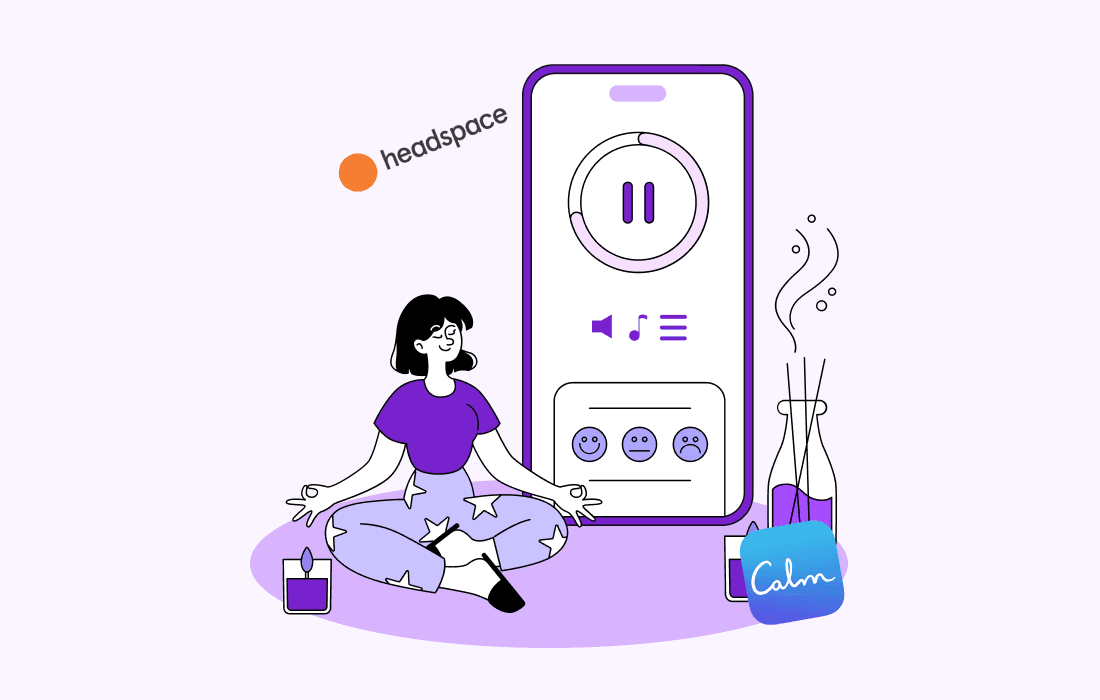
In today’s world, stress and anxiety have unfortunately become constant companions. This has made people seek solace in mindfulness and meditation practices. As a result, the popularity of meditation apps has increased significantly.
The meditation app market is anticipated to hit US$4.64 billion in 2023, with an annual growth rate of 11.04%.
Headspace and Calm, the best free meditation apps, collectively dominate 70% of the market.
Terms like “mindfulness apps” and “yoga for beginners apps” have seen a surge of 65% annually in searches for meditation apps.
If you’re also intrigued by the concept of a meditation app and want to impact numerous lives, read along.
In this blog, we’ll explore the secrets of meditation app development that capture users’ attention and represent the spirit of mindfulness.
Table of Contents
An Overview of Headspace and Calm Meditation Apps
The two trailblazers of the meditation industry, Headspace and Calm, have set new benchmarks.
These two giants have earned their laurels by combining technology and mindfulness to create an oasis of mental serenity for millions worldwide.
- Headspace App: Founded by Andy Puddicombe, it offers a user-friendly platform with various guided meditation sessions. The Headspace app is focused on stress reduction, sleep improvement, and mindfulness. It features structured meditation courses for beginners and advanced practitioners. It also has animated videos that explain meditation concepts.
- Calm App: The Calm app boasts a vast library of guided meditations, sleep stories, and relaxing music, catering to different preferences. It offers celebrity-narrated content and customizable meditation timers. The app emphasizes relaxation, stress relief, and better sleep.
Both apps have achieved massive success by bringing meditation and mindfulness to a worldwide audience.
Top Features to be Included in Meditation Apps
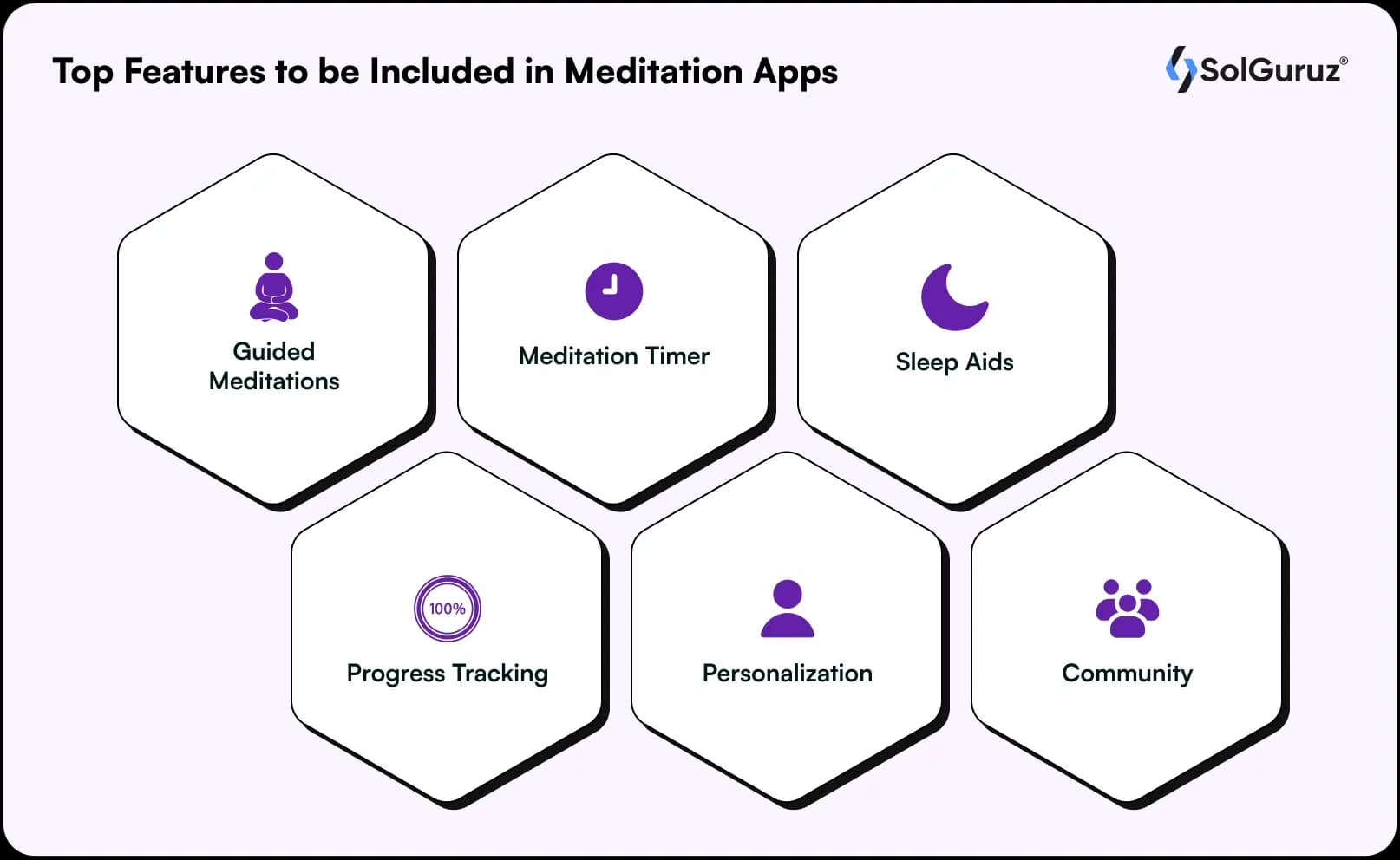
A meditation app aims to aid meditation practices and skills. Here are some features to keep in mind during your meditation app development:
- Guided Meditations: Guided meditations are pre-recorded audio or video sessions that lead users through various meditation techniques. They provide detailed instructions. The goal is to make it simpler for novices to understand and efficiently practice meditation.
- Meditation Timers: Mediation timers allow users to set the durations for their meditation sessions. People who like to meditate alone and without instruction will find this option useful.
- Sleep Aids: Sleep aids are made to encourage relaxation and ensure good sleep. To aid users in falling asleep quietly, they include calm music for sleep, like white noise or the sounds of nature. In addition, sleep meditations can induce sleep while calming the mind.
- Progress Tracking: Progress monitoring lets users keep track of their meditation routines and accomplishments over time. It contains information on the number of sessions finished, the total number of minutes spent meditating, and the number of consecutive days spent doing so. It’s a great tool to include in your meditation app that encourages people to meditate regularly.
- Personalization: Meditation apps tailor the meditation experience to each user’s preferences. The app can incorporate questionnaires and surveys depending on the users’ stress levels, preferred mediation techniques, and goals. Based on this data, the app might suggest particular meditation programs or content to suit the user’s requirements.
- Community and Social Features: These features in your app can enable users to stay connected with like-minded people and share their meditation journey. It will facilitate a more interesting and delightful experience for the users. These features also allow them to participate in challenges, group meditations, or conversations about various aspects of mindfulness.
These basic features of a mindfulness app can enhance the user experience, cater to diverse preferences, and encourage consistent meditation practice. So bear these considerations as you start developing your meditation app.
Challenges You Might Face While Creating Calm & Headspace App
While make an app like Calm or Headspace, you definitely come across many benefits. Although there are enough challenges
Developing free apps like Calm presents numerous difficulties. There are a lot of challenges you may encounter when building a successful meditation app for your users, like long loading times and high subscription fees. Here, we have listed out some challenges –
1. Slow Loadings and Inconvenience
The biggest problem facing the team of app developers you hire is providing the application with many options without sacrificing its simplicity or loading speed. Loading speed greatly affects customer retention and is directly connected to user convenience.
2. Need for Content Localization for Apps
When it comes to app localization, creating multilingual apps presents a number of significant problems. Again, it would be difficult for your contracted app partners to mitigate those issues and deliver the app on a prearranged timetable.
3. Trust Building
Currently, the market is filled with several apps for mindfulness meditation. However, only a few of them have strong research support. Because of this, customers are now unsure about which apps to use and which not to. This makes it difficult for entrepreneurs to gain these clients’ trust and retain them on their platform. Something that is achievable if you provide your app’s operation with the proper amount of transparency.
How Much Does It Cost to Build a Meditation App Like Headspace And Calm?
Several factors determine the cost of meditation app development, like Headspace and Calm. Here are some of them:
- Chosen platform (Mobile, Web, TV, Wear, etc.)
- The complexity of the app
- Number of features
- Designing of the app
- The tech stack required for meditation app development
- Team size required for developing a meditation app solution
- Location of the meditation app development company
Depending on your specific requirements, developing an app like the Headspace app or Calm can take from $30,000 to more than $100,000.
How do Meditation apps make money?
One of the most common methods of making money with a meditation app is through a freemium model. This approach offers the basic version of the free meditation apps for free. The free version lets users access limited meditation sessions and features.
However, users must subscribe to a premium version to access more advanced application features. The paid version has a broader range of guided meditations, advanced features, and additional content. The subscription fees charged to users who opt for the premium version create a steady income stream for the app owners.
If you have a free meditation app, you can encourage partnerships and collaborations. You can collaborate with prominent meditation teachers, spiritual leaders, or mental health experts to offer exclusive content or courses. These collaborations often involve revenue-sharing agreements. The profits generated from subscriptions or purchases are split between the two parties. Apart from this, you can also display targeted advertisements to free users.
Do you know that people who meditate multiple times daily are willing to invest more than $20 monthly for meditation subscription services?
Choosing the right tech stack for your meditation app
The tech stack refers to the collection of programming languages, frameworks, libraries, and tools used to create an application. The best free meditation apps are built on a solid tech stack. The tech stack chosen directly impacts the app’s performance, user experience, and scalability.
When you start developing your meditation app, it is recommended mainly for mobile. If required, you can launch Tablet and TV apps later on, depending on user demand.
The best tech stack for developing a meditation app like Calm includes Flutter, Native Android, and Native iOS. We suggest choosing Flutter as your meditation app development platform, as it possesses cross-platform frameworks capabilities.
- With Flutter, you can maintain a single source codebase. It will enable you to create both Android and iOS apps seamlessly.
- Moreover, Flutter offers excellent scalability and maintainability while significantly reducing development time and costs.
When you choose a tech stack for meditation app development, there are several considerations to remember.
- App’s complexity
- Development teams’ skill and experience
- Time-to-market
- Future scalability
Selecting a dependable and effective programming language like Python, Java, or Node.js is a good starting point for backend development.
On the other hand, tools like HTML5, CSS3, and JavaScript are ideal for a responsive and visually appealing front-end user experience. The most well-known front-end frameworks are Vue.js, Angular, and React.
The Process of Meditation App Development

Here is the step-by-step process for meditation app development like Headspace or Calm:
1. Research and Planning
First and foremost, research and planning are the initial steps in meditation app development like the Headspace app or Calm. Understanding the various meditation apps can help you choose your target market, differentiators, and design components.
At this phase, you need to thoroughly understand the target market’s unique demands, preferences, and pain points concerning meditation and mindfulness practices. Conduct a market analysis to identify current rivals, their pros and cons, and their distinguishing characteristics.
Some common meditation apps are:
- Guided Meditation Apps
These apps provide users with pre-recorded meditation sessions led by experienced instructors or soothing voices. Users can choose from various topics, durations, and styles to suit their preferences. - Mindfulness Apps
Mindfulness apps focus on helping users stay present and aware of their thoughts and emotions. These apps may offer guided mindfulness exercises, breathing techniques, and tools to encourage daily awareness. - Sleep and Relaxation Apps
These apps help users relax and fall asleep more easily. They often include guided meditations designed for better sleep, ambient calm music for sleep, and bedtime stories. - Personalized Meditation Apps
Personalized apps offer customized meditation experiences based on the user’s preferences and goals. They may use user data and feedback to curate meditation sessions tailored to individual needs. - Meditation Timer Apps
Meditation timer apps provide meditation timers with interval bells and ambient sound options. It helps the users keep track of their meditation sessions.
Once you decide on the type of app you want to create, start with a prototype.
2. Building a Prototype
Making a prototype is the next step in meditation app development. This app’s prototype is an early version that makes it easier to visualize its main features and user interface.
Focus on developing a minimal yet functional version that encapsulates the key elements of the app’s capabilities. This phase includes meditation sessions, calming music, and progress monitoring. Meditation apps’ most highly valued features are activity trackers and media features.
You can test the app’s usability using the prototype, get user feedback, and pinpoint areas for development. It stimulates the finished product and also helps the design process. The flexibility of a prototype lets you evaluate, analyze, and ensure your idea will stand the test of time.
3. MVP Development
Developing a Minimum Viable Product (MVP) is one of the most essential steps in the meditation app development process. A minimum viable product (MVP) acts as the very first version of an app. It typically incorporates all the necessary features. This iteration is made to cater to the needs of the target audience.
An MVP’s primary objective is to collect insightful user feedback while minimizing the time and cost spent on meditation mobile app development.
You can release a condensed version of your app containing the most crucial meditation sessions, a straightforward user interface, and fundamental features. It will enable you to test the idea in the real world.
The MVP strategy maximizes the potential for the success of the product. It ensures that resources are used effectively and that the final product is suited to the preferences and requirements of the users.
4. Beta Testing
After developing a Minimum viable product (MVP), the next crucial step is to conduct beta testing before its full-scale release to the public.
The beta testing stage in the meditation app development lets you obtain input from actual users. It also enables you to spot potential problems or errors you may have yet to notice during internal testing.
A small user base, known as beta testers, is given access to the MVP during beta testing. These testers are drawn from or serve as a representative sample of a wide range of potential users. They use the product in actual situations and offer insightful feedback on usability, functionality, and the overall user experience.
The beta testing feedback is crucial for fine-tuning the MVP. It helps make the required adjustments and improve performance. It also ensures that the finished product satisfies user expectations and is consistent with the planned objectives.
5. Launch
Launching your app is the final stage in meditation mobile app development after beta testing has gone well. It’s essential to ensure that all the beta testing feedback has been carefully included in the app’s final version before the launch. All the bugs or problems should be fixed to facilitate an enhanced user experience.
For a lasting impact, consider preparing a mobile app launch strategy. This entails disseminating information about the app via multiple media, including press releases, app review websites, and social media. Creating a buzz before a launch might help spark initial interest and draw new consumers.
Collaborations with celebrities or meditation specialists can increase the app’s popularity and reputation. Lastly, continuous monitoring and support are essential to deal with unforeseen issues after launching your best meditation app.
6. Gathering Feedback
The critical next step after successfully launching your meditation app is actively soliciting user feedback. You can use feedback as a valuable compass to help you understand the app’s advantages and disadvantages and the overall user experience.
To understand which app features are most popular with your audience, spot any usability concerns, and assess general happiness, you can invite users to submit their ideas and comments.
Additionally, monitor user feedback and comments in the app store. It will let you identify recurring trends and swiftly fix any urgent issues. With feedback analysis, setting specific goals for improving the app and its features can be more accessible.
7. Measure User Engagement
After the meditation app’s successful launch, measuring user engagement became important in determining whether your meditation app development was a success. Some key metrics to measure user engagement include active users, session frequency and timing, and other specific actions. Analyzing these indicators will give you insights into how well the product can hold users’ attention.
Additionally, keeping track of user comments, evaluations, and reviews offers insightful data on user happiness and potential improvement areas.
A high degree of user involvement shows that the app connects with its intended audience and advances meditation and mindfulness. Moreover, ongoing user engagement tracking enables the development team to deploy iterative upgrades and optimize the app’s features for overall maintenance and improvement.
8. Monetize your Meditation App
Lastly, monetization tactics are essential to maintain the app’s growth and ensure long-term success. While trying to make money from the app, preserve the user experience.
Offering a freemium model is one of the most popular strategies for this. This strategy offers the app’s fundamental meditation content without charge to entice users to discover its advantages.
Besides, premium services, such as advanced meditation programs, customized sessions, or unique content, can be available through in-app purchases or subscription plans.
Partnerships with wellness specialists, well-being experts, or well-known influencers can also increase the app’s appeal and revenue potential. Joint activities, promotions, and cross-platform advertising can draw a larger user base.
The secret to effectively monetizing meditation software is striking a balance between retaining profitability and preserving a peaceful, distraction-free atmosphere for users.
How Can SolGuruz Help You Create a Meditation App, If Not Like, But Better Than Headspace And Calm?
Creating a meditation app that stands out from rivals and exudes serenity and tranquility like no other can be challenging!
But our solutions are more significant than the challenge.
Check out this detailed case study of a meditation app project:
 SolGuruz understands what it takes to create an immersive and captivating meditation app that will resonate with users worldwide.
SolGuruz understands what it takes to create an immersive and captivating meditation app that will resonate with users worldwide.
At SolGuruz, we understand the profound impact of meditation on mental well-being. We infuse this understanding into every line of code and every pixel of design we create. Our expertise lies in crafting elegant and user-friendly interfaces and in curating expertly guided meditation content that touches the hearts and minds of users.
Whether you envision a gamified meditation experience, personalized journey plans, or seamless integration with wearables, we bring your dreams to life, tailoring each feature to meet your app’s unique vision.
Join hands with SolGuruz, and let’s embark on a soulful adventure together.
Wrapping Up
The key to ensuring an impactful meditation app development lies in finding your idea based on the users’ needs.
Building a captivating user interface, offering expertly curated content, and incorporating interactive features are crucial elements that elevate a meditation app from ordinary to exceptional.
However, the goal behind meditation mobile app development shouldn’t be based on chasing profits. It should extend to changing lives for the better.
So, with determination and a mindful spirit, you can create the best meditation app that not only rivals Headspace and the Calm app but also leaves a lasting impact on the well-being of individuals worldwide.
FAQs
1. What are some popular meditation techniques that I should include in my app?
Some popular meditation techniques to add to your app include breathing exercises, walking meditations, guided meditation, calming meditation, and insight meditation, among others.
2. How can I ensure a seamless audio experience for guided meditations in the app?
To create a seamless audio experience, optimize audio file formats for efficient streaming and download, use high-quality audio recordings, and offer offline access. Enhance user convenience by implementing speed control, sleep timers, and cross-platform syncing during guided meditation sessions.
3. Do paid meditation apps work?
Yes, paid meditation apps are a promising idea. If your meditation app offers effective tools, sleep stories, and meditation techniques, people will be willing to pay for it.
4. How much time does it take to develop a meditation app like Calm or Headspace?
The cost and time to develop an app like Headspace and Calm depend on several factors, with the starting range for development time and budget around $20,000.
5. How can I incorporate progress-tracking and goal-setting features in the app to enhance user engagement?
Incorporate progress-tracking and goal-setting features by allowing users to set meditation goals, track their session durations, and earn rewards or badges for consistent practice.
6. What are the best practices for monetizing a meditation app, and what revenue models can I explore?
Best practices for monetizing a meditation app include offering a freemium model, one-time purchases for specific content, and subscription tiers that offer diverse content and features.
Create a Calming Meditation App
Develop a meditation app to help users relax and find peace. Our team can build an engaging and effective app for you.

Strict NDA

Trusted by Startups & Enterprises Worldwide

Flexible Engagement Models

1 Week Risk-Free Trial
Give us a call now!

+1 (724) 577-7737
